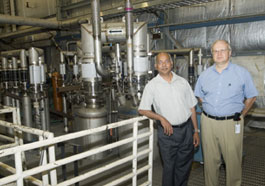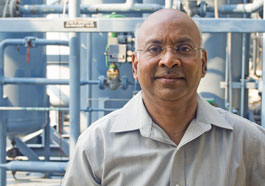
Venkatarao (Rao) Ganni, Jefferson Lab's deputy Cryogenics Group leader (left), and Dana Arenius, Cryo Group leader, pause while walking through a section of Central Helium Liquefier distribution piping. Photo by Greg Adams, JLab.
A new process invented by Jefferson Lab engineers has revolutionized the way helium cryogenic plants work, saving electricity costs at several scientific research facilities. The cycle requires very few or no new components and nearly doubles the lifetime of refrigeration equipment, while improving system reliability, availability, stability and efficiency. Although the benefits of the process are fully realized for new plants, portions of the new process have already been demonstrated on existing systems with significant results.
Jefferson Lab's Continuous Electron Beam Accelerator Facility, located in Newport News, Va., uses superconducting niobium cavities to accelerate electrons for nuclear physics experiments. Jefferson Lab cryogenically cools the cavities to between -452 and -456 degrees Fahrenheit with liquid helium, which causes the metal to become superconducting - resulting in close to zero electrical resistance in the metal.
Like Freon, helium is a refrigerant. Jefferson Lab's refrigeration system uses a continuous closed cycle that's similar to that of a home air conditioner. The helium is compressed by a series of compressors and then cooled by water, liquid nitrogen, and a set of turbines. Then the helium is allowed to expand through turbines, making it even colder. As it's used to cool the niobium cavities and other equipment at the Lab, the helium begins warming up again. At which point it's then sent back through the system, starting the process over again.
When less refrigeration was needed in the past, the same amount of helium was sent through the compressors at full operating pressures; that resulted in the compressors using the same amount of electricity as if the system was producing full refrigeration capacity. Venkatarao (Rao) Ganni worked in industry before coming to Jefferson Lab's Cryogenics Group. He notes that the helium compressors were designed to work efficiently at the unit's maximum cooling capacity. "In industry, we were asked by our customers to guarantee this maximum capacity, although that operating point is higher than the daily operating needs," Ganni says.
Ganni and his colleagues reconfigured Jefferson Lab's existing refrigeration system controls to automatically scale back the compressors when full capacity isn't needed. The new process, dubbed the Ganni Cycle, slashed the power requirements of the refrigeration system from 6 Megawatts (MW) to 4.2 MW, resulting in a savings of $33,000 each month at the Lab. It has also increased the time between necessary maintenance periods for the compressors from 45,000 hours to 74,000 hours.

Venkatarao (Rao) Ganni, Jefferson Lab's deputy Cryogenics Group leader and primary developer of the Ganni Cycle, stops to have his photo taken in front of the Central Helium Liquefier oil removal system. Photo by Greg Adams, JLab.
What's more, Dana Arenius, head of the Cryogenics Group, says implementing the new cycle didn't require a lot of new equipment. "It uses the same equipment. However, what the Ganni Cycle does change is how the system is controlled and how it's configured," he notes.
Ganni says the Cryogenics Group's origins in industry allowed its members to design and implement the new cycle. "It takes very specialized people to figure out how to get the machine to turn down efficiently, because the compressors weren't originally designed for that purpose. You need to know what the [operating] envelope of each piece of the machine is," he says.
Portions of the Ganni Cycle have also been implemented at other Department of Energy (DOE) facilities for existing plants. In a cooperative energy savings collaboration with Jefferson Lab, the Brookhaven National Laboratory, located in Upton N.Y., initiated a program to upgrade the Relativistic Heavy Ion Collider (RHIC) cryogenic system where portions of the Ganni Cycle were applied to help increase the efficiency of the helium liquefier. The collaboration reduced the refrigerator electric power consumption by 35 percent, from 9.2 MW to 6 MW. The RHIC staff has also reported an increase in system stability and reliability. At the Spallation Neutron Source at Oak Ridge National Lab in Oak Ridge, TN, a similar collaboration centering on optimizing the 2K (Kelvin) helium cryogenic plant operation led to a 32 percent electric power reduction, from 3.8 MW to 2.6 MW.
Dennis Kovar, DOE Associate Director of the Office of Science's Office of Nuclear Physics, praises the Cryogenics Group's energy-saving efforts. "Cryogenics improvement could have a positive impact on all superconducting radiofrequency facilities now and in the future," he says.
Other facilities are working with the Cryogenics Group to reduce their cryogenics electricity requirement through implementation of the Ganni Cycle. The cycle has been submitted to the U.S. Patent Office for review and a patent is pending. The group has also fully automated Jefferson Lab's refrigeration facilities, the first cryogenics plant to do so, using a computer-based control system for round-the-clock load-matching efficient operation, without the need for round-the-clock staffing.
Jefferson Lab's Cryogenics Group is part of the Accelerator Division's Accelerator Engineering Department. The group maintains and operates the Central Helium Liquefier, the largest 2K refrigerator in the U.S. The group also operates the End Station Refrigerator (ESR), which supports cryogenic needs in all three of Jefferson Lab's experimental halls, and the Cryogenic Test Facility, which supports accelerator component research and development.
For additional information, please contact Debbie Magaldi (magaldi@jlab.org or call 757-269-5102), or after Sept. 1, Kandice Carter (kcarter@jlab.org, phone 757-269-7263).

